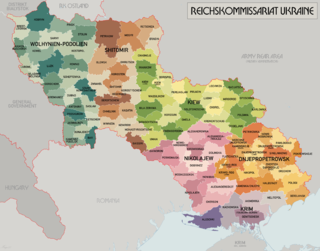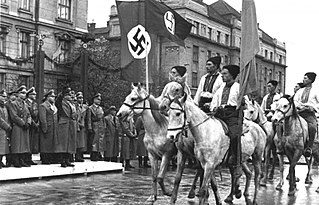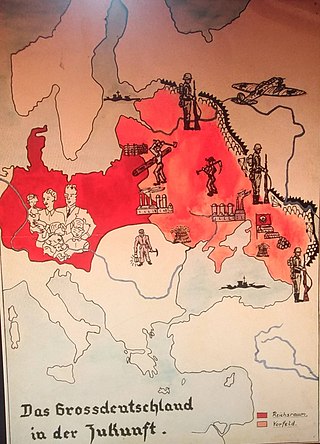
Lebensraum is a German concept of expansionism and Völkisch nationalism, the philosophy and policies of which were common to German politics from the 1890s to the 1940s. First popularized around 1901, Lebensraum became a geopolitical goal of Imperial Germany in World War I (1914–1918), as the core element of the Septemberprogramm of territorial expansion. The most extreme form of this ideology was supported by the Nazi Party and Nazi Germany. Lebensraum was a leading motivation of Nazi Germany to initiate World War II, and it would continue this policy until the end of the conflict.
Reichskommissar, in German history, was an official gubernatorial title used for various public offices during the period of the German Empire and Nazi Germany.

Erich Koch was a Gauleiter of the Nazi Party (NSDAP) in East Prussia from 1 October 1928 until 1945. Between 1941 and 1945 he was Chief of Civil Administration of Bezirk Bialystok. During this period, he was also the Reichskommissar in Reichskommissariat Ukraine from September 1941 until August 1944 and in Reichskommissariat Ostland from September 1944. After the Second World War, Koch stood trial in Poland and was convicted in 1959 of war crimes and sentenced to death. The sentence was later commuted to life in prison and Koch died of natural causes in his cell at the Barczewo prison on 12 November 1986.
The New Order of Europe was the political and social system that Nazi Germany wanted to impose on the areas of Europe that it conquered and occupied. Planning for the Neuordnung had already begun long before the 1939 start of World War II, but Adolf Hitler proclaimed a "European New Order" publicly on 30 January 1941: "The year 1941 will be, I am convinced, the historical year of a great European New Order!"

During World War II, Reichskommissariat Ukraine was the civilian occupation regime of much of Nazi German-occupied Ukraine. It was governed by the Reich Ministry for the Occupied Eastern Territories headed by Alfred Rosenberg. Between September 1941 and August 1944, the Reichskommissariat was administered by Erich Koch as the Reichskommissar. The administration's tasks included the pacification of the region and the exploitation, for German benefit, of its resources and people. Adolf Hitler issued a Führer decree defining the administration of the newly-occupied Eastern territories on 17 July 1941.

Reichskommissariat Moskowien was the civilian occupation-regime that Nazi Germany intended to establish in central and northern European Russia during World War II, one of several similar Reichskommissariate. It was also known initially as the Reichskommissariat Russland, but was later renamed as part of German policies of partitioning the Russian state. Siegfried Kasche was the projected Reichskomissar, but due to the Wehrmacht's failure to occupy the territories intended to form the Reichskommissariat, it remained on paper only.

The Reichskommissariat Kaukasus, also spelled as Kaukasien, was the theoretical political division and planned civilian occupation regime of Germany in the occupied territories of the Caucasus region during World War II. Unlike the other four planned Reichskommissariats, within the borders of the proposed Caucasus Reichskommissariat experiments were to be conducted for various forms of autonomy for "indigenous groups".

The Transnistria Governorate was a Romanian-administered territory between the Dniester and Southern Bug, conquered by the Axis Powers from the Soviet Union during Operation Barbarossa. A Romanian civilian administration governed the territory from 19 August 1941 to 29 January 1944. A brief military administration followed, during which the Romanians withdrew from the region by late March 1944. German control became official on 1 April 1944.

During World War II, in the course of Operation Barbarossa, Nazi Germany invaded Estonia in July–December 1941, and occupied the country until 1944. Estonia had gained independence in 1918 from the then warring German and Russian Empires. However, in the wake of the August 1939 Nazi-Soviet Pact, the Stalinist Soviet Union had invaded and occupied Estonia in June 1940, and the country was formally annexed into the USSR in August 1940.

Reichskommissariat is a German word for a type of administrative entity headed by a government official known as a Reichskommissar. However, many offices existed, primarily throughout the Imperial German and Nazi periods, in a number of fields it is most commonly used to refer to the quasi-colonial administrative territorial entity established by Nazi Germany in several occupied countries during World War II. While officially located outside the German Reich in a legal sense, these entities were directly controlled by their supreme civil authorities, who ruled their territories as German governors on behalf of and as representatives of Adolf Hitler.

Ukrainian collaboration with Nazi Germany took place during the occupation of Poland and the Ukrainian SSR, USSR, by Nazi Germany during the Second World War.

The Arkhangelsk–Astrakhan line, or A–A line for short, was the military goal of Operation Barbarossa. It is also known as the Volga–Arkhangelsk line, as well as the Volga–Arkhangelsk–Astrakhan line. It was first mentioned on 18 December 1940 in Führer Directive 21 which enunciated the set goals and conditions of the German invasion of the Soviet Union, describing the attainment of the "general line Volga–Archangelsk" as its overall military objective.
The Hunger Plan was a partially implemented plan developed by Nazi bureaucrats during World War II to seize food from the Soviet Union and give it to German soldiers and civilians. The plan entailed the genocide by starvation of millions of Soviet citizens following Operation Barbarossa, the 1941 invasion of the Soviet Union. The premise behind the Hunger Plan was that Germany was not self-sufficient in food supplies; to sustain the war and keep up domestic morale, it needed food from conquered lands at any cost. The plan created a famine as an act of policy, killing millions of people.

The Reich Ministry for the Occupied Eastern Territories was created by Adolf Hitler on 17 July 1941 and headed by the Nazi theoretical expert, the Baltic German Alfred Rosenberg. Alfred Meyer served as Rosenberg's deputy. The German government formed the ministry to control the vast areas captured and projected for capture by the Wehrmacht in Eastern Europe and Russia. The ministry also played a part in supporting anti-Soviet groups in Central Asia.

Siegfried Kasche was an ambassador of the German Reich to the Independent State of Croatia and Obergruppenführer of the Sturmabteilung (SA), a paramilitary wing of the Nazi Party. Kasche was the proposed ruler of the Reichskommissariat Moskowien, but the Reichskommissariat failed to materialize. He was hanged for war crimes in Yugoslavia on 7 June 1947.

Reichskommissariat Turkestan was a projected Reichskommissariat that Germany proposed to create in Russia and the Central Asian republics of the Soviet Union in its military conflict with that country during World War II. Soviet historian Lev Bezymenski claimed that names Panturkestan, Großturkestan and Mohammed-Reich were also considered for the territory.
Wehrbauer, plural Wehrbauern, is a German term for settlers living on the marches of a realm who were tasked with holding back foreign invaders until the arrival of proper military reinforcements. In turn, they were granted special liberties. Wehrbauern were mainly used on the eastern fringes of the Holy Roman Empire and later Austria-Hungary to slow attacks by the Ottoman Empire. This historic term was resurrected and used by the Nazis during the Second World War.
The Ural Mountains played a prominent role in Nazi planning. Adolf Hitler and the rest of the Nazi German leadership made many references to them as a strategic objective of the Third Reich to follow a decisive victory on the Eastern Front against the Soviet Union.

During World War II, the Crimean Peninsula was subject to military administration by Nazi Germany following the success of the Crimean campaign. Officially part of Generalbezirk Krym-Taurien, an administrative division of Reichskommissariat Ukraine, Crimea proper never actually became part of the Generalbezirk, and was instead subordinate to a military administration. This administration was first headed by Erich von Manstein in his capacity as commander of the 11th Army and then by Paul Ludwig Ewald von Kleist as commander of Army Group A.











